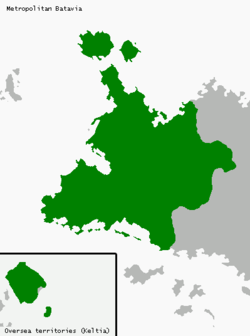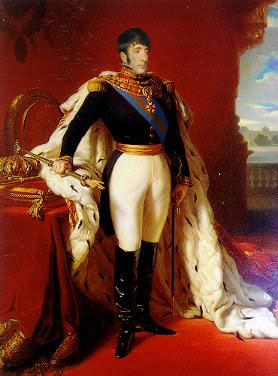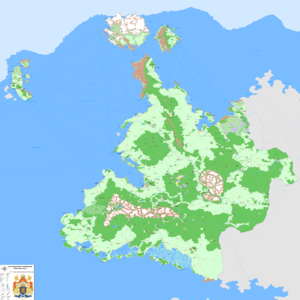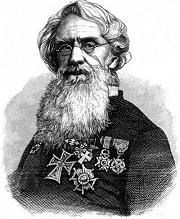Batavia
| Kingdom of Batavia Koninkrijk Batavië | |||
| |||
| Motto: Batavia erit in orbe ultima (Common Tongue: Batavia will continue to exist until the end of the world!) | |||
| Anthem: Staatshymne der Bataven (Common Tongue: State hymn of the Batavians) | |||

| |||
| Map versions | (16.2.1) 16.2.6 - present | ||
| Capital | 's Koningenwaarde | ||
| Largest city | 's Koningenwaarde, Kingsrise | ||
| Official language(s) | Official language: Batavian (Dutch) | ||
| Official religion(s) | Holy Catologian Church | ||
| Demonym | Batavian | ||
| - Adjective | Batavian | ||
| Government | Constitutional monarchy | ||
| - King of the Batavians |  Frederik II | ||
| - Prime Minister |  Joseph des Vinandy-Windsor | ||
| - Legislature | Staten-Generaal: | ||
| Establishment | 09 Sprokkelmaand 1513 AN (09.02.2006) | ||
| Area | NA | ||
| Population | 59,394,806 (1710 AN) | ||
| Active population | 2 | ||
| Currency | Kruys (BAK) | ||
| Calendar | New Batavian Calendar (months); Norton calendar (years) | ||
| Time zone(s) | CMT-11 Benacian territories), CMT+10 (Keltian territories) | ||
| Mains electricity | 230/400 V - 50 Hz | ||
| Driving side | right | ||
| Track gauge | 1,435 mm (4 ft 8 1⁄2 in) | ||
| National website | Website | ||
| National forum | Forum (1) | ||
| National animal | Bataafse leeuw (Batavian lion) | ||
| National food | Waarder sausage (Waarder worst) | ||
| National drink | Dietish Wine (Dietse wijn) | ||
| National tree | Oak (Quercus) | ||
| Abbreviation | BAT, BA | ||
Batavia, officially the (Sixth) Kingdom of Batavia, (Dutch: Koninkrijk Batavië or Zesde Koninkrijk Batavië), is an imperial dominion of Shireroth in the west of Benacia. The country borders Elwynn in the northeast, Kalgachia in the east, the Unified Governorates of Benacia in the southeast. The Great Western Sea is located to its south and west, making it one of the nation's natural borders. In addition, the country has territory on the Madison Isles and some oversea colonies. The capital of Batavia, which is located at the Koningenbaai, is called 's Koningenwaarde, which is translated as Kings' Worth. Other important and heavily populated cities are Davignon and - more recently - Kingsrise.
Originally, the several feudal states were unified in 1513 AN by Regent Jodocus van Haltna and organised into the Free Batavian States. The nation saw a series of changes in its administration, especially a progress of democratization during the first ten Norton years after its unification. It reached a peak in influence and power during the Second Kingdom Era (1523 - 1579 AN), in which it successfully played a moderate - and sometimes leading - role in international diplomacy. It succeeded in maintaining good relations with Shireroth and Stormark throughout the 16th century, while carving out its own oversea empire on Micras.
Batavia saw a decline in power at the end of the sixteenth century, and a final collapse in 1614 AN, after which its territories were carved up between Stormark, Jingdao, Shireroth and -later - minor successor states, such as Kasterburg. Within Batavia, nationalist tendencies continued to linger, represented by the Free Batavian Society, lead by later Prime minister Joachim Mackay.
The Sixth Kingdom came to see the light in 1669 AN, after the coronation of Arkadius IV, and saw - by means of various treaties - the return of large parts of its original Batavian territory under the Batavian flag. While the Batavian Revolution of 1685 brought some constitutional reforms, like the growing importance of the Hogerhuis and a new dynastic ruling house, the political elite deemed it important to keep a sense of continuity. The Sixth Kingdom, while reformed, remained in place.
The Kingdom is dominated by a wealthy bourgeoisie and nobles, who reinstated the parliamentary constitutional monarchy. Originally, the king retained considerable emergency powers over the parliament, but these powers were limited after 1685. Its legislation is built around the two Huyzen of the Staten-Generaal: the Lagerhuis (House of Commons), which claims to be the oldest popular democratic assembly of Benacia still in existence, and the Hogerhuis (House of Lords). The latter is dominated by the representatives and lords of the many lordships of the Realm.
Batavia is a member of the Micras Treaty Organisation (MTO) and was member of the Collective Security Association (CSA) untill 1711 AN.
General
Etymology
The name "Batavia" comes from the mythical story of the origin of Batavia. According to this mythical story, the Batavians come from the "good island", or as in the primeval Batavian "batawjō".
Read here more about the mythical stories.
Maps
The kingdom has a rich collection of maps. Even when Batavia appeared on the MCS map, a map already existed. Then Batavia was situated east of the RefoBliek, from where most of the Batavians came from. After the claim on Micras was accepted, a map of Batavia on Micras was drawn. That map has been the basis for the following detailed map:
History
- See the Batavian history prior to 1661 AN.
- See Timeline of Modern Batavia since 1661 AN.
A list of the several states, which were Batavia:
Free Batavian States: 1513 - 1520 AN (9 february - 4 september 2006)
In 1513 AN (February 9, 2006) the Free Batavian States (Dutch: Free Batavian States) were founded by Jodocus van Haltna. He came from the Refoweb Republic, or Refobliek, where other Batavians came from. Faya Veronique was crowned Queen, she was very popular because she listened to the people.
First Kingdom of Batavia: 1520 - 1523 AN (4 september - 2 december 2006)
The Free Batavian States disintegrated after several unrest, after which in 1520 AN the First Kingdom of Batavia arose. The inactive queen was replaced by Arkadius Leopold des Vinandy, better known as Arkadius I. But the unrest did not stop and the kingdom ended.
Davignonrepublic: 1523 AN (2 december - 28 december 2006)
In 1523 AN created the Republic of Davignon (Dutch: Davignonrepubliek), an unofficial name for the shortlived revolutionary state which led to a revival of the kingdom.
Second Kingdom of Batavia: 1523 - 1579 AN (28 december 2006 - 24 august 2011)
The 16th century of the Second Kingdom (between 1523 and 1579 AN) has generally been seen as the Golden Era of the Batavian people: the Empire successfully became a great power and could influence international crises, participated in major political and economical organisations (like the Small Commonwealth) and waged some successful wars which increased its territory or fame. To the contrary of most nations in that time, the power of the Crown was considerably less than that in nations like Shireroth, Natopia or Babkha. In a time of absolute monarchies, it was a functioning constitutional monarchy with strong democratic values.
Third Kingdom of Batavia: 1579 - 1585 AN (18 october - 12 november 2011)
The end of the 16th century would see the rise of dissent and divide between the population: the Oogstmaand Monarchy and Third Kingdom would soon fall under internal military pressure, while its successor nations would often fail to conciliate the whole Empire's territories.
Thz Third Kingdom began with the rise of political anarchy in 1579 AN, effectively ending the Golden Era of the Second Kingdom. With the Lagerhuis failing to organise fair elections, the King took charge of government. This period (between 1579 and 1581) would be referred to as the Oogstmaandmonarchie (Oogstmaand Monarchy) and saw Arkadius III take on both the role of monarch as head of government.
An uneasy power struggle would dominate the Third Kingdom, as monarchists and parliamentarians, attempted to gain power through the new constitution (which strengthened the King's position, while restoring the Lagerhuis).
In 1582 AN, a coup attempt by Constantijn Windsor - who acted as military commander at the time - saw the reformation of the Third Kingdom into a militarised Batavian State with Davignon as capital. King Arkadius III lost his throne and fled to Paravel (an island before the coast of 's Koningenwaarde). Plotting against the military which had betrayed him, Arkadius launched a counter-attack. Having landed near 's Koningenwaarde in 1583 AN with a small army of royalists, he successfully gained control of the former capital. Renaming the kingdom into Greater Kingdom of Batavia, power was seized in several lordships which had vowed support to the military in 1582. The country, now further divided than ever, was in a state of civil war until both sides agreed to a peace treaty in 1585.
Fourth Kingdom of Batavia: 1585 - 1591 AN (3 february - 6 august 2012)
United Kingdom of Batavia: 1591 - 1592 AN (6 august - 15 september 2012)
Fifth Kingdom of Batavia: 1592 - 1614 AN (15 september 2012 - 15 july 2014)
Stateless period: 1614 - 1661 AN (15 july 2014 - 3 june 2018)
From 1614 AN and onwards most of its territories were little by little divided among other major powers, like Jingdao (which had been a colony, and later constituent nation of Batavia), Stormark and Shireroth.
United Batavian States: 1661 - 1669 AN (3 june 2018 - 9 February 2019)
In 1661 AN, the Batavian territories saw an increase in militancy among several groups who advocated a free and independent Batavia (like the Free Batavians). Those movements, further supported by Batavians who had fled into the eastern territories (which had opened up after the collaps of Minarboria), became increasingly vocal in local assemblies. States like Kasterburg and the Transbataafsche Vrystaat would eventually pressure the Shirerithian and Jingdaoese authorities in re-establishing an independent state.
Sixth Kingdom of Batavia: 1669 - present (9 February 2019 - ...)
With the ascension of Arkadius IV on the Throne in 1669 AN, a final agreement with Shireroth led to the return of Batavian territory in hands of the government at 's Koningenwaarde, while establishing a custom union to strengthen the ties between the Benacian people. The Sixth Kingdom saw a return to many of the values of the First and Second Kingdom: returning its root to a strong parliamentary tradition, while keeping the King as a strong figurehead, while being able to act in times of need. However, as of 1678, King Arkadius has assumed all powers of the Batavian government under an emergency clause in the Constitution, ruling Batavia all by himself.
In 1680 new elections were held for the Lagerhuis and Prime Minister, which restored the democratic order and ended the state of emergency.
In an attempt to improve its diplomatic position, a joint assembly offered the crown of Batavia to Kaiseress Salome in 1685 AN. On 17.VI.1686, the Shirerithian Imperial Advisory Council gave Salome its approval of accepting the Batavian offer of the crown, and the Landsraad resolved two days later the same. The matter was immediately communicated to the Batavian ambassador in Shireroth in an audience with the Kaiseress. In 1691 AN a Tripartite Treaty was concluded, whereby the StaatsHolder abdicates in favour of Hendrik Leopold des Vinandy, who succeeds his brother as King of Batavia.
A political change occurred at the elections of 1709, when two controversial treaties were concluded. The kingdom lost territory, the Brettish Isles and the Beneluccas, as well as Frankish arms. All this happened under legal but devious methods. Gisela Starck lost the elections, her party - Conservative Monarchist Party - lost 55 seats in the Lagerhuis. After elections, a criminal investigation was launched into the course of events.
At the end of 1709 AN, rumours began to circulate about the king's absence. This became painfully clear after pictures of a sick king in Leylpur appeared in the media. The throne speech of 1710 was not read by the king but by the regent. The political turmoil caused by the king's absence, forced the government not only to ask crown prince Frederik Alfons to step in, but also to start secret negotiations with the Shirerithians through Jingdaoese diplomats (whose country was recently re-integrated into the Imperial Republic) residing into the country.
In 1711 AN, Frederik Alfons ascended the throne as king Frederik II, while the des Vinandy-Windsor Cabinet passed the Treaty of Raynor's Keep, formally binding the Kingdom and the remnants of its empire to the Imperial Republic of Shireroth. The population's reactions differed, from anxious to simply uninterested. While the peasantry remained apathetic to the change, nobility saw it as their chance to strengthen their position within the legal system of the Kingdom, while industrialists - eager to protect their wealth - eagerly welcomed the new import and export markets (with investments from Greater Kildare increasing with 230% in the first month).
Batavia, as of date, is the sole constitutional monarchy within Shireroth. Despite attempts of nobility to limit the powers of the Lagerhuis, its democratic traditions are strongly enshrined into the nation's fundaments. A growing movement is even pushing to reinstate the Folksraad, to increase the voice of the commoners in the Imperial government.
Geography
The Hoorner Land, to the southeast of the Issel and Linge rivers, is dominated by forests to the north and cultivated farmland to the south. In the past, the latter area consisted mainly of marshes, to which the name Hoorne refers. The Nysus Mountains is a mountain range that stretches 1250 km from the junction of the rivers Linge and Issel to the Great Braec marshland. South of the Nysus Mountains, the Kabah forests stretch towards the coast. The lowlands of the southwest coast are called the Voltrue Belt.
The south coast has many bays, the largest of which is called Regentenwater, an inland sea with outer islands. Typical are the sandbanks that fall dry during low tide, separated by more or less deep gullies. Some other inlets have hardly or no sandbanks falling dry and stand out from deep sea hollows.
North of Great Braec is the Irrel Woud, named after the Irrel River that flows from the Nysus Mountains. The deepest inlet is King's Bay (Batavian: Koningenbaai), into which the rivers Linge, Meuze and Oer flow. In the catchment area of the Linge and Zwette rivers, on the eastern shore of King's Bay lies the Waarder Woud. North of the King's Bay is the Ingel Woud, a forested area surrounded by cultivated land along the coast. The Ingel Woud is bordered by the Rhine River.
The course of the Rhine River is determined by the Ingel Ridge. This ridge stretches from the Créte d'Ortan to the Austrasian Mountains. The islands of Sneeuwland and Ravaria are separated from continental Batavia by the Strait of Shalta. Sneeuwland is a rugged mountain landscape with an arctic climate. The island of Ravaria is shielded from the cold climate by the western mountain ridge, giving the eastern lowlands a sufficiently warm climate to alternate between forest and cultivated land.
The northern coast of continental Batavia, along the Northern Sea, is also dominated by large and small inlets. The largest inlet is the Baie de Bjorka, which is separated from the Northern Sea by the Ile de Saint-Jean. The north-eastern area, which is called La Lande de Taxandrie, is a sallow area. South of it is the Kolenbranderswoud, which rises further to the Austrasian Mountains. Between these mountains and the Waarder Woud is the Hoog Falwawoud, an area where forests, heaths and sand drifts alternate. The eastern border lies at the foot of the Octavian Mountain Range. The area in the eastern corner is an alternation of cultivated land and forests.
Demographics
As a result of Batavia's turbulent history, the population fluctuates within the borders of the kingdom. In 1692 AN another census was taken, which had not taken place since 1670 AN. The strong population growth was due to the annexation of Gascony after the fall of Francia. The addition of Kasterburg brought in over 3 million inhabitants. With the transfer of Los Bananos to Elwynn, the 947,863 inhabitants were transferred. But the incorporation of Frankfort and Esthersbýur added 753,056 inhabitants to the kingdom.
| Year | Population |
|---|---|
| 1588 | 15,302,000 |
| 1669 | 10,842,404 |
| 1670 | 14,668,254 |
| 1692 | 48,265,485 |
| 1693 | 48,796,405 |
| 1694 | 49,381,962 |
| 1695 | 50,023,927 |
| 1696 | 50,624,215 |
| 1697 | 51,282,329 |
| 1698 | 52,102,847 |
| 1699 | 52,728,081 |
| 1700 | 53,360,818 |
| 1705 | 56,640,234 |
| 1710 | 59,394,806 |
Government and politics
King of Batavia

The King of Batavia, and between 1579 and 1661 AN known as King of the Batavians is the title of the head of state of the Kingdom. Civil strife, and chaos, throughout the history of the nation led to the decision that one who wants to claim the Throne, must be coronated and govern from 's Koningenwaarde itself. With the nomination of a foreign monarch, Salome of Shireroth, as new Queen, dignitaries were presented by the fact that the Kaiseress-Queen would be unable to live for a long time in the capital. Therefore, it was decided during the Blanckenhof Akkoorden that a title of Staatshouder was established: a queen in both privileges and crown, but without the title.
Traditionally, there are a few dynasties which - through tradition and blood - have a rightful claim on the Throne: the Vinandists, in support of the House of Vinandy, have a large backing among the population and nobility. The Windsorists, supporters for the house of Windsor, are mostly backed by southern nobility. This goes back hundreds of years, from when the Windsors ruled Dietsland, which was the main adversary of both the House of Veronique (first stadtholders and later kings of 's Koningenwaarde) and the House of Vinandy before - and during the first years of - the nation's unification. The Windsorists hold reasonable power among the clergy, often holding high offices within the Church.
The House Veronique is traditionally seen as the royal family which established Batavia as a kingdom. Their rule as dominating and uniting dynasty can be traced back eras before Batavian unification. While challenged by the other families, they stayed in charge of the Free Batavian States. The death of the childless queen Faya, however, meant the downfall of the dynasty. The Vinandy's, who had strengthened their powerbase and received support of the regent, Jodocus van Haltna, successfully claimed the Throne. Their rule, from time to time challenged by others, often marked the highpoints in Batavia's history. Their remarkable comebacks, made it one of the most resilient and sometimes even feared households in the Kingdom.
The Kalirionists are widely known as a small group of fervent supporters of the House of Ayreon-Kalirion. They originally gained support when the House of Windsor lacked a decent heir in 1664 AN. Support arose for David Ayreon-Kalirion in the silent hope to regain territories which were, at the time, occupied by Shireroth. Those plans failed, with Arkadius IV strengthening his position and Joseph des Vinandy-Windsor finally having children (and a heir).
In 1685 AN, to cement its position, the crown was presented to Salome of Shireroth. She became Steward of the Throne (Staatsholder) of Batavia in 1685 AN.
Prime Minister
See also: Prime Minister of Batavia.
The Prime Minister is the head of the Batavian government. For eight Norton years (between 1661 and 1669 AN) this title was merged with the office of Stadtholder, but it never caught on and eventually was renamed to Prime Minister (Batavian: Minister-President). The Hogerhuis advises the King on who should become prime minister (this is often preceded by talks between political parties), who then appoints one. Afterwards, support from the Lagerhuis is required to get a cabinet running.
The prime minister has ministerial responsibility towards the King and the Royal Household, while acting as the most important domestic and international interlocutor and representative of the Kingdom.
Batavian Staten-Generaal
The Batavian parliament - officially known as Staten-Generaal since 1622 AN, is a bicameral system with an aristocratic element. The Lagerhuis (house of commons) is directly elected every four Norton years. The members of the Hogerhuis (house of lords) were originally appointed by the king, from among the nobility of the country. Since the Blanckenhof Akkoorden, every noble who represents a lordship holds a seat in the Hogerhuis. Representatives of Free or Royal Cities are are often appointed by the King, or by the local council.
Administrative Divisions
Originally Batavia was divided into regions (gewesten). During the United Batavian States, some of these regions were transformed into states. When Batavia had possession to roughly the former regions Dietsland and Transingel, this area was subdivided into lordships. With the reunification of the Batavian countries, this division has been further implemented. This further expanded after the Batavian Revolution, with Gasconian, Neustrian and Ravarian territories being added. Because of this, Batavia is now divided in over 96 lordships.
The provinces (gewesten), which were formed during the early days of the Batavian Free States as States, still serve as a purely symbolic administrative and cultural division. Theses days, they merely serve as electoral district of the Lagerhuis and lost their political power over the region. Sometimes a governor is still appointed among local nobility as sign of respect, but the position holds no power.
The lordships themselves exist of several types and sizes:
- Cities
- Free City (Vrije Stad): these cities hold autonomy over their own affairs. They have their own representation in the Hogerhuis. The city charter, approved and signed by the Royal Court, records its level of autonomy.
- Royal City (Rijksstad): Cities which have become Royal Cities hold the same level of autonomy as a Free City. However, they are more closely linked to the Royal Court. In Hogerhuis, their representative is almost every time appointed by - or with approval - of the King. They have been used to strengthen the position of the Court within the House of Nobles.
- Lordships
- Lordship (Heerlijkheid)
- Barony (Baronie)
- Viscount (Burggraafschap)
- County (Graafschap)
- Duchy (Hertogdom)
- Archduchy (Aartshertogdom)
- Abbey principality (Abdijvorstendom)
- Principality (Vorstendom / Prinsdom)
Foreign relations
Batavia was a member of the Batavian Confederation (Batavian: Bataafse Bond) and the Franco-Batavian Empire, which were both disbanded in 1685 AN. Today, the kingdom conducts a sovereign foreign policy. But because of its stormy existence in recent decades, the country is very cautious. The kingdom is not a member of any alliance, pursues a policy of neutrality and refuses citizens from non-treaty countries.
Culture
Proverbs
"Van hier tot aan Qavaqaqqaqqaniitqerqertaq"
Literally, “from here to Qavaqaqqaqqaniitqerqertaq”. Which means: a dilemma or extremely long.
"Even Catoloogs als Constantijn"
Literally, “As Catologists as Constantijn”. Which means: very fickle, often changes opinion or religion.
"Een RL'er in de Catodraal krijgen. (un rl'ur in du kátódrál kreigun) (Republikeins Links)"—unknown
Literally, “Getting an RL in the Cathedral”. Which means: To get something impossible done.
"Al zijn de Vlamingen nog zo snel, Batavië achterhaalt gij wel"—unknown
Literally, “Though the Flemings are still so fast, Batavia will catch up with you”.
"De tong van een vinandist"
Literally, “The tongue of a vinandist”. Which means: talking about a lot of little rules and details, while loosing view over what's really important.
Calendar
Batavia has used different calendar systems throughout history. The so-called Arkadian Calendar arranged that the year was started on the founding date of Batavia. The Batavian Calendar contained thirteen months and a fourteen day week. Both calendar systems have not had broad support. The New Batavian Calendar has had the most support, namely where the Gregorian month names were replaced by their own names. This calendar is most similar to the current calendar system.
The current calendar system has different names for the weekdays and for the months. The weekdays and the months are linked to the Gregorian calendar. The Norton Calendar is used for the years.
Weekdays:
- Sunday: Eerste dag (First day)
- Monday: Tweede dag (Second day)
- Tuesday: Derde dag (Third day)
- Wednesday: Midweek
- Thursday: Vijfde dag (Fifth day)
- Friday: Zesde dag (Sixth day)
- Saturday: Baddag (Bathday)
Months:
- January: Louwmaand (Tanning month)
- February: Sprokkelmaand (Collection month)
- March: Lentemaand (Spring month)
- April: Grasmaand (Grass month)
- May: Bloeimaand (Flowering month)
- June: Zomermaand (Summer month)
- July: Hooimaand (Hay month)
- August: Oogstmaand (Harvest month)
- September: Herfstmaand (Fall month)
- October: Wijnmaand (Wine month)
- November: Slachtmaand (Slaughter month)
- December: Wintermaand (Winter month)
Microvision
Batavia has already participated in Microvision several times, an overview:
| Year | Song | Position |
|---|---|---|
| 2009 | "Opstand der Bataven" | 3rd of 8 |
| 2009 | "Tribute" | 4th of 8 |
| 2009 | "Killing in the Name" | |
| 2018 | "Vier seizoenen heeft een jaar" (Four seasons has a year) | 14th of 14 |
| 2019 | "De wilde boerendochter" (The wild peasant's daughter) | 22th of 26 |
| 2020 | "Mooie dag" (Nice day) | 16th of 33 |
| 2021 | "I Belong to You" | 10th of 27 |
| 2022 | "Zwevend naar ’t geluk" (Floating to happiness) | 30th of 46 |
Sinterklaas
The feast of Sinterklaas is celebrated annually with the giving of gifts on St. Nicholas' Eve (5 Wintermaand) in Batavia. The festivities traditionally begin each year in mid-November (the first Saturday after 11 Slachtmaand), when Sinterklaas "arrives" by a steamboat at a designated seaside town. The steamboat anchors, then Sinterklaas disembarks and parades through the streets on his horse, welcomed by children cheering and singing traditional Sinterklaas songs.
In the weeks between his arrival and 5 Wintermaand, Sinterklaas also visits schools, hospitals and shopping centers. He is said to ride his white-grey horse over the rooftops at night, delivering gifts through the chimney to the well-behaved children. Before going to bed, children put their shoes next to the fireplace chimney of the coal-fired stove or fireplace (or in modern times close to the central heating radiator). They leave the shoe with a carrot or some hay in it and a bowl of water nearby "for Sinterklaas' horse", and the children sing a Sinterklaas song. The next day they find some candy or a small present in their shoes.
Saint Nicholas' Eve, 5 Wintermaand, became the chief occasion for gift-giving during the winter holiday season. The evening is called Sinterklaasavond ("Sinterklaas evening") or Pakjesavond ("gifts evening", or literally "packages evening"). On 6 Wintermaand "Sinterklaas" departs without any ado, and all festivities are over.






